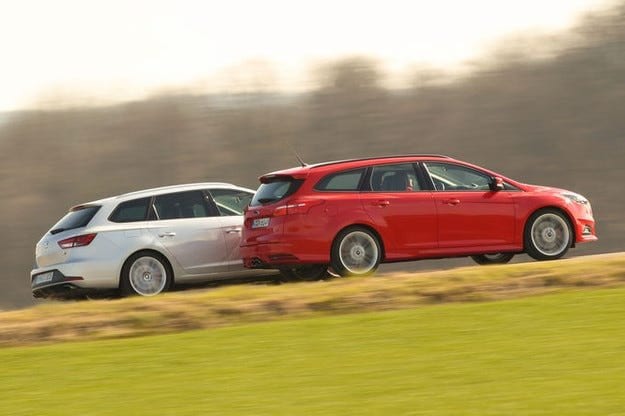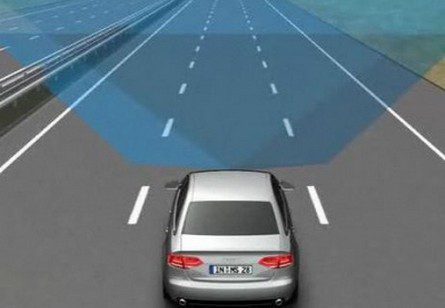
Test drive Ford Focus ST Turnier collides with Seat Leon ST Cupra
Content

Who said transportation and sports should be mutually exclusive
Ford Focus ST Turnier and Seat Leon Cupra ST. Two practical family vans that handle both luggage and sports riding equally well. The Seat impresses with its hot temperament, while Ford boasts a more serious transport talent. Fast and practical at the same time? These two cars combine qualities that make them an interesting phenomenon for the compact class.
“Come on, stop rummaging through those chests every time, people!” Perhaps at this point you will be asked to scream - or at least part of you. But this time, you are not quite right - unless someone really gives five bucks for how much he holds the trunk of his car, he is unlikely to settle for a van, be it a sports one. However, both test participants can also be ordered in the hatchback version, which means they can be more attractive in appearance. If you dive into the data on the proposed cargo volume, at first glance the Seat looks like a professional car carrier: its nominal boot capacity is 587 liters (Ford: 476 liters), and with the rear seats folded down, it is 1470 liters (Ford: 1502 liters). However, in real life, as soon as you open the back cover, you can't help but wonder where the hell that hefty amount of paper has gone. In a well-made, but low cargo compartment, it is almost impossible to collect large items. In the same way, tests to check the maximum size of the transported cargo - everything that exceeds 56 centimeters will have to be placed in an additional roof rack. Or in a trailer. Or just transport it in another car, but not in this one. Significantly larger objects (up to 72 cm high) can enter the Focus through the large loading gap.
ST stands for high expectations
Why, then, is Ford still not winning in body scoring? This is due to its not-so-intuitive ergonomics, the noises that show up when driving over broken sections, and a bit of sloppy handling in the cargo area. When it comes to safety, the Focus doesn't have anything special to offer either. Thing is, it comes with an even wider selection of driver assistance systems, but its braking system is nowhere near as good as that of its Spanish rival. For example, to stop at a speed of 190 kilometers per hour, a Ford needs six meters more than a Seat. Which is actually somewhat surprising, because powerful brakes are one of the things we've come to expect from Ford's sporty models.
In general, the ST abbreviation in Ford traditionally causes high expectations - for example, we immediately think of the magnificent five-cylinder engines of the recent past. Unfortunately, their time has passed, but the modern four-cylinder successor has retained many of the characteristics of its iconic predecessor. Acoustic design was obviously an important part of the model's design. The four-cylinder engine under the hood of the Focus boasts a charming sound and very good traction. However, in direct comparison with the Seat, the Ford's 250-litre engine takes a little longer to accelerate from low revs and tends to respond slightly more slowly when accelerating. This may not be due to the ten newton meters difference, but partly due to the fact that the Spanish model achieves maximum thrust 111 rpm earlier. The biggest difference, however, is that the Focus weighs 80kg more than the Leon. The result is especially noticeable in the sprint from 120 to 9,9 km / h. It is logical that more weight has a negative effect on fuel consumption. On average, Ford consumes 100 liters per 9,5 km, while Seat is content with 100 liters / XNUMX km.
When physics is close
It's time to get on the Seat. What immediately impresses: the seats here are set much lower. The driving position is like in a real sports car - and that's good. Touring or not, the Cupra doesn't want to betray its athletic genes. Although the Volkswagen's two-liter engine doesn't sound as appealing as its rival, its traction is up to the mark. And since every engineer who has ever tuned a chassis understands that 350 Nm must put a load on the front axle, here we have a self-locking front differential. So the front wheels really rarely spin like a front wheel drive car. Even in very tight corners, the front wheels do not weaken their powerful grip on the asphalt, which is felt by the steering stiffening. Feelings in this car at times resemble racing.
a car in civilian armor - a similar phenomenon was observed in the first generation Focus RS.
The ST has to do without a mechanical differential lock, so the driver soon begins to feel like 360Nm is hitting the front axle: as soon as the pressure in the turbocharger increases, the front wheels begin to lose traction and the steering wheel vibrates. Suspension adjustment is decidedly stiff, but still flexible enough to provide decent handling on uneven surfaces. However, Seat is one car that shows how well a car in this category can drive. Its adaptive dampers eliminate any possibility of body shake, but also prevent bumps from causing too much impact. Overall, the Cupra handles more precisely and predictably - the subjective feel of lightness is really impressive - behind the wheel, you could tell it's in a model that's one digit short of the Focus. So anyone who wants to use their station wagon as a sports device will no doubt be satisfied with Seat's capabilities. The sports tires (Michelin Pilot Sport Cup 2) included in the optional Performance Package even stand out. Don't miss the Brembo sports brake system with four-piston calipers and perforated discs at the front measuring 370 x 32 mm. For such additions, Ford buyers will have to contact a tuning specialist.
In the end, one way or another, Ford managed to close the gap a little to the Seat, the victory deservedly goes to the Spanish model. It's simply the better of the two sports wagons - albeit with the caveat that it's more of a sports car than a practical wagon.
Text: Markus Peters
Photo: Hans Dieter Zeufert
Evaluation
Ford Focus ST Turnier – 385 points
The Ford definitely positions itself as the more practical station wagon, but that's the only way it outperforms the Seat - aside from subjective engine sound ratings, which aren't awarded points.
Seat Leon ST Cupra – 413 points
Except for the relatively high price and limited options for transporting oversized cargo, Seat does not allow for any weak points. He deservedly wins in all nominations when assessing qualities.
technical details
| Ford Focus ST tournament | Seat Leon ST Cupra | |
|---|---|---|
| Working volume | 1997 | 1984 |
| Power | 184 kW (250 hp) at 5500 rpm | 195 kW (265 hp) at 5350 rpm |
| Maximum torque | 360 Nm at 2000 rpm | 350 Nm at 1750 rpm |
| Acceleration 0-100 km / h | 6,8 with | 6,7 with |
| Braking distances at a speed of 100 km / h | 37,8 m | 36,6 m |
| full speed | 248 km / h | 250 km / h |
| Average consumption fuel in the test | 9,9 l / 100 km | 9,5 l / 100 km |
| Base Price | 61 380 levov | 49 574 levov |
